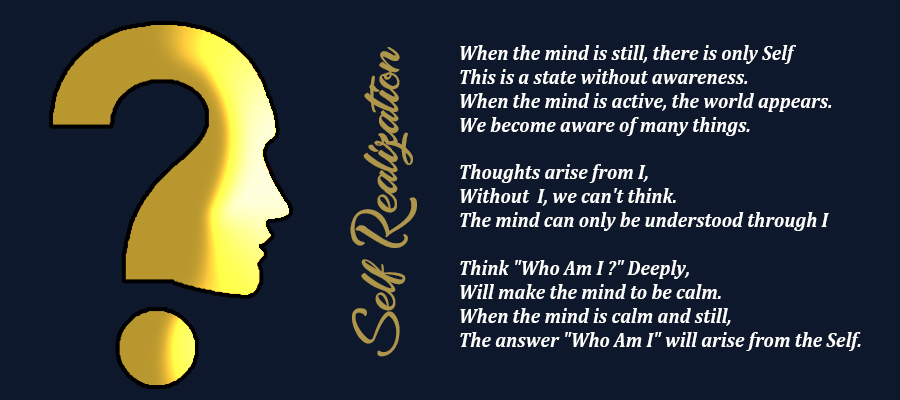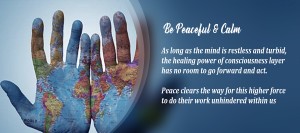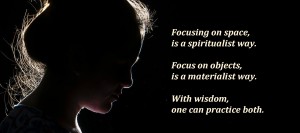Self-inquiry is an awareness of the awareness itself. It leads us beyond duality because the object of meditation (the “I”) is ultimately revealed as the Subject itself (the transpersonal Consciousness). Nevertheless, in order to let the question “Who am I?” bring us closer to our real nature, or in other words, to truly ask “Who am I?” in an efficient way, a certain understanding and spiritual maturity is necessary. We cannot answer rationally and intellectually to such a question. When we state “I understand, I know who I am” we are actually conceptualizing that which in reality is ineffable.
Asking “the Question” while we are centered in the head can stimulate the mind, and can make this process of inquiring nothing else but mental imagery. When we abandon any striving in order to mentally know the answer, (when we simply accept an answer like “I don’t know”) to the Question, we are in a state of complete Open Attention.
Rational knowledge is characterized by duality, is sequential and is always partial. But when we relate to the Spiritual Heart, to our true “I,” this knowledge should be of another kind, total and complete, and this is only possible if our ego – with its personality, mind, feelings, etc. does not intervene.
All the searching for who we really are gives rise to a sacred wonder or astonishment because it escapes any sort of understanding. Then, because of the attitude of surrender, we have the feeling that all our limits dissolve into the infinite and a re-orchestration of our energies is produced. In it, all the energies converge towards the Ultimate Subject, towards the Spiritual Heart (which brings beauty, love, and freedom). Therefore, we should ask the essential question “Who am I?” without expecting a rational answer, but, rather, in a state of surrender to a sacred wonderment, to a mystical intuition about who we really are.
In this way, we give up the usual approaches to knowledge, because we realize that the mind cannot contain the mystery of the answer. Therefore, the emphasis shifts from the preoccupation of finding out who we are (which, in the beginning of Self-Enquiry is still done in accordance with our usual mentality, with the rational mind) to the pure presence of the Spiritual Heart.
We can love, admire, and embrace this question-intuition in regards to our existence. Consequently, it will slowly cease to have a rational, objective, conscious character. As it is an answer impossible to formulate, we will free ourselves of the snare of conceptualization and be able to have access to the totality that the Spiritual Heart Consciousness awakens in us.
The question “Who am I?” should be repeated with sincerity, as often as possible, but we must not ask it of the mind in order not to receive just superficial answers connected with that which we already know about us and our memories of the past.
Moreover, to live under the mark of “the Question” by savoring the state of mystery which it stirs in the Spiritual Heart, but not allowing it to be touched or tinged by any conceptualization, we will learn another manner of existing. In this new attitude, the intuition of our Ultimate Reality dominates and we are in a perpetual surrender and expectancy, in an unconditional openness towards the ineffable mystery of the pure “I am.”
The question “Who am I?” exists in us in a latent state and emanates profoundness and creates harmony in our whole being. This harmony itself brings the recognition of our divine existence. What remains is just a feeling of profound recognition. It originates from the untold depths of our being. It was affirmed that the question “Who am I?” comes to be formulated spontaneously when the answer-intuition of our real nature is already suggested.
In the Self-Enquiry Method of Ramana Maharshi, the question “Who am I?” has a very special quality because it is an interrogation that makes the mind enter into a state of void. If we have the wisdom and adequate training of the mind not superimpose anything on this void (no concepts, no attributes), the Reality of the Spiritual Heart, atman, emerges.
The Spiritual Heart, being the Ultimate Subject, cannot be known by means of methods or systems. When we truly understand this, a kind of surrender comes about in our being and it penetrates us; all our inner energies that were previously mobilized by thoughts, desires, and by our personality, in general, enter into a peace-bringing equilibrium.
Trying to reveal “The Ineffable” with the help of the question “Who am I?” is not a common meditation on some specific object.
The Spiritual Heart, atman, is not, as we have clearly stated before, an object. In such a meditation, we remain lucid, without interpreting, without judging, simply following the intimate feeling of existence. This feeling is not unknown, but just usually ignored because of our different identifications with the body, mind, etc.
It follows that any time the mind tends to hold on to a concept in the desire to explain and make objective the ineffable experience of the Supreme Self, it is necessary to remember the famous Vedantic negation “Neti, Neti.” (Not this, nor that).
The path of Self-Enquiry is, in fact, elimination of all that is known, because, for the moment, the direct knowledge of the Supreme Self’s true nature is missing. Only by eliminating what is known (our thoughts, perceptions, and emotions) will it be possible to reveal the Ultimate “I,” the Eternal Present. Thus, we immerse ourselves in attention that becomes increasingly intimate and profound concerning our true nature.
This Question itself is born from stillness and it is also fed from the silence that we sometimes create in our mind and in our being. Thus, because of the silence, spontaneous inward awareness of who we naturally appear.
Who am I?
I am not an organ of perception, I am not an organ of action, I am not a thought, I am not knowledgeable and I am not all of this.
If everything is negated, then who am I? I am consciousness, also known as awareness.
What is awareness?
Awareness as a cognitive alert condition is where you are aware of yourself and your situation and have knowledge about it. The purest form of consciousness is the Self. Impure consciousness is our mind; mind because the purest form of consciousness is polluted by various thought processes that are produced in the mind.
The purest consciousness is Sat-cit-Ananda (existence-consciousness-happiness). The state of realization of Sat-cit-Ananda by negation is the purest form of consciousness. Awareness under normal conditions works closely with the mind. With thoughts subdued, consciousness will not be there. When the mind is subdued, we become unconscious (the part of the mind where the psychic activity takes place that the person is not aware of) and this is the purest form of consciousness, also known as the unconscious state. This we experience in a state of deep sleep and also during meditation. Our consciousness can be purified by using our breath effectively.
When will the Self be realized?
There are two aspects. One is the universe (Prakṛti) seen and the other is the Self, which is the seer (witness). Unless what is seen disappears or disappears, the seer cannot be realized. As long as we identify objects as they really are, the Self cannot be realized, because this is duality. The world that appears before us is māyā, illusion, which plays two roles. One, hiding the true nature of the Self and the other projecting the universe as real (illusion).
Visible is what we see with the help of our biological eyes. We see trees and recognize them as trees. We see elephants and recognize them as elephants. When we see these objects, we identify them with their shapes and forms.
When can this illusory world be eliminated?
The world of illusion can be eliminated only if the mind and all its cognitions and actions are subdued. The mind is the only factor leading to the path of self-realization.
What is mind?
Self strength in the form of thought processes is called thought. Mind processes and thoughts are no different. Therefore the mind is not a separate entity such as the organ of action and cognition. The mind is full of thoughts. The purity of mind is based on the quantity and quality of thought processes. That is why the mind is called subtle and forms part of antaḥkaraṇa (mind, intelligence, and ego). Apart from thought, there is no such thing as mind. In an active state, there are too many thoughts and in a dream state, even though we don’t have too many thoughts, there are still thoughts that appear as dreams. But in a deep sleep, we have no thoughts. These are the stages in the way of manifesting the Self.
How to understand the mind?
How does thought arise? It comes from “I”. Only after the appearance of “I” (the first person), you and us (second and third people) appear. Without “I”, the mind cannot think of you and us. Therefore, the mind can only be understood through “me”.
By constantly asking in “Who am I”, the mind can calm down. The mind “Who am I” destroys all other thought processes in the mind and the mind becomes calm. When the mind is calm, we get the answer to the question “Who am I”.
“When other thoughts arise, one should not pursue them, but must ask: ‘To whom does it arise?’ It doesn’t matter how many thoughts come up. When each thought arises, one must ask diligently, “To whom does this thought arise?” The answer that will appear is “For me”. Then if someone asks “Who am I?” The mind will return to its source, and the mind that arises will become silent. With repeated practice in this way, the mind will develop the skills to stay at the source. When subtle thoughts go through the brain and sense organs, gross names and forms emerge; when it lives in the heart, its name and form disappear. ”
Externalization of the mind leads to the thought process and internationalization of the mind leads to Self-realization. When the mind is associated with external objects, the power of “I” in the form of ego arises. As long as “I” is in our minds, the ego also coexists with the mind.
When the ego is removed, “I” is not there. If “I” disappears, then who is the culprit? Isn’t that Self?
Is there no other way to make the mind calm?
Apart from investigations, there are no adequate facilities. If by other means it is sought to control the mind, the mind will appear to be controlled but will come out again.
Through breathing control too, the mind will become calm; but will remain silent only as long as the breath remains controlled, and when the breath continues, (controlling the breath means slowing the breath) the mind will also move again and will wander as if driven by the remnants of the impression. The source is the same for the mind and breath. The mind, indeed is the nature of the mind. The “I” thought is the first thought of the mind, and that is egoism. From there, ego and breath originate.
Therefore, when the mind is calm, the breath is controlled, and when the breath is controlled, the mind becomes calm.
But in deep sleep, even though the mind becomes calm, the breath does not stop. This is because of God’s will so that the body can be protected and others may not be in the impression that it’s dead.
In the samādhi condition, when the mind becomes calm the breath is controlled. Breath is a dirty form of mind. Until death, the mind keeps the breath in the body; and when the body dies, the mind takes a breath with it.
Therefore, breathing control exercises only help to calm the mind. It will not destroy the mind (known as manonāśa). Like the practice of breathing control, a meditation on God’s forms, repetition of mantras also calms the mind. so that the body can be sustained and others may not be under the impression that it is dead.
Now let’s try it with a spell. The mantra must be understood, analyzed, and must be contemplated in the mind to protect the mind from the stimulation of the sense organs. If this is done, the mind becomes calm. Mantra is not meant to be read by sitting in a place using Japa mālā. We must meditate using spells. Over a period of time, the mantra will be absorbed into the mind, which sits an inch above the ājñācakra.
This is called the absorption of the mantra into the mind and the subtle vibrations of the mantra not only purify the mind, but also intelligence, ego, and consciousness.
As we know the mind, intelligence, consciousness, and ego are known as antaḥkaraṇa and are explained as internal organs, the center of thought and feeling; mind and thinking ability; conscience and soul. Look at this antaṇkaraṇa and everything is related to internal capabilities. One must learn to work on antaṇkaraṇa with a mantra to get the full benefit of the mantra. There is no point in counting the number of repetitions and instead one must use a spell to conquer the mind.
Thoughts appear in the mind like waves in the sea. How to?
When the intensity of the Self-inquiry increases, the thought process automatically disappears. In other words, when the quality of meditation increases, all other thought processes are dissolved and when there is no thought process, our consciousness becomes pure and the purest consciousness is the Self.
What is the nature of Self?
The self is nothing but the Truth (satyaṁ jñanaṁ anantaṁ Brahman – truth, knowledge, and infinity) The world, the individual soul, and God are appearances in it. All three appear at the same time and disappear at the same time.
Self is that where there is absolutely no “I” thinking. That is called “silence”. The self itself is the world; The self itself is “I”; The self itself is God; all are Shiva, the Self. Therefore the Self is called omnipresent.
The teacher will only show you how to let go; they will not automatically bring the soul to a state of liberation. Each person must in his own way take the path shown by the Master and achieve self-realization. One can know oneself only with one’s own eyesight, and not through the eyes of others. Therefore, spiritual experiences differ from person to person. It will never be the same. Shiva does not need a mirror to know him.
One must make a silent mind; therefore their conclusive teaching is that the mind must be made silent; once this is understood, there is no need to read endlessly. If someone continues to read, it will cause confusion.
To calm the mind, we only need to ask ourselves what the Self is.
How can this search be done in a book? One must know oneself with one’s own wisdom eye.
The self is in five veils, but the book is outside. Because the Self must be investigated by removing five veils, there is no point in looking for it in books. There will be times when a person must forget everything he has learned. This is called “unlearning”. When someone has realized the Self it means that realization has been preceded by non-existence





